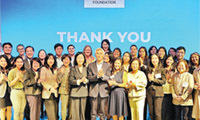Jobless Young in Japan Learn the Art of Protest

In Japan, young people unfamiliar with social campaigns have sought out training. A would-be activist in Tokyo practicing his technique.
By HIROKO TABUCHITOKYO
A GROUP OF YOUNG people recently gathered in a darkened park here. Holding placards and megaphones, they chanted slogans condemning the Japanese government and a lack of jobs and opportunity.
The scene, which is repeated often in the gritty Tokyo neighborhood of Koenji, is nothing close to the protests that have recently shaken Iran. Indeed, the protests would hardly raise an eyebrow in most parts of the world, but in this country, which values conformity, they represent a stark departure from the norm. Since the 1960s, when youth protests turned violent, even the mildest form of protests by young people has been viewed as taboo.
But the pain of recession is changing that, giving rise to a new activism among Japan’s youth, who have long been considered apathetic.
“I’m here because I want to change society,” one leader, Yoshihiro Sato, 28, recently shouted to a crowd of about 50. “Will you join me-” Unlike the ‘60s generation, which agitated to change the bourgeois basis of Japanese society, Mr.Sato and other young people are today fighting to join it. They are demanding greater professional opportunities, more job security and a stronger social safety net. After so many decades without a grassroots movement, protests are so rare here that many who wish to take part require basic training.
The Tokyo-based Pacific Asia Research Center, an institute that typically runs seminars on social issues like poverty, organized the recent march. After a surge of interest from young people who said they wanted to get more involved in social issues but did not know how, the center started offering what it says is Japan’s first activist training program. The sessions include poster-making and campaigning on the Web.
“Once we’re done, we’ll overrun Japan with demonstrations,” Seiko Uchida, the head of the research center, told a crowd.
That may be hyperbole, but the deteriorating economy has inarguably affected young people more than any other demographic. Unemployment was 9.6 percent in April for Japanese aged 15 to 24, compared with 5 percent unemployment over all.
But unemployment and welfare benefits are sparse in Japan. And government spending is skewed toward pensions and health care for older voters rather than programs that might train young workers or help them support their families.
In the first quarter of the year, Japan’s economy shrank a devastating 14.2 percent on an annual basis, as exports slumped because of the global economic slowdown.
Many of those who lost their jobs were younger people in precarious “temporary” positions that were the product of a decade-long deregulation.
The disparity has fueled generational friction, particularly between those who reaped the fruits of Japan’s rapid postwar growth and younger Japanese who came of age in Japan’s “Lost Decade” of the 1990s, when the country’s economic growth stagnated, and during its anemic recovery.
When companies like Canon and Toyota Motor started to fire temporary factory workers late last year, a handful of the workers lashed out publicly, confronting managers at factory gates, often in front of TV cameras. Others brought a flurry of lawsuits against former employers.
Today, workers are rushing to unionize, and the Japanese Communist Party says it is getting about 1,000 new members a month, many of them disgruntled young people.
Still, most Japanese remain deeply averse to confrontation and protest. “Japanese feel it’s shameful to get involved in protests,” said Makoto Yuasa, a longtime activist. “Many still look at us suspiciously, like we might be making bombs.” Still, “this is the most significant rise in activism I’ve seen in years,” said Yoshitaka Mouri, a professor at the Tokyo University of the Arts, who has been following the rising protest culture.
Some experts question how much political influence demonstrators will wield. Young people are outnumbered by older voters, and are concentrated in cities, where ballots carry less weight, proportionally, than in the sparsely populated countryside.
To quell the rising anger, the government has increased spending on programs for younger people. In his latest economic stimulus package, Prime Minister Taro Aso pledged 1.9 trillion yen ($19 billion) in programs to raise youth employment. He is also prodding companies to elevate temporary workers to full-time status. Such actions have done little to change the economic issues.
For now, the public has some sympathy with the protesters, and the rallies get heavy coverage in local media. “I support these young people,” said Masaaki Saito, 60, an owner of a small electronics store in Koenji who took part in student protests in his youth. “It’s been a long time,” he said, “but Japan’s youth are getting their voice back.”
스마터리빙
more [ 건강]
[ 건강]이제 혈관 건강도 챙기자!
[현대해운]우리 눈에 보이지 않기 때문에 혈관 건강을 챙기는 것은 결코 쉽지 않은데요. 여러분은 혈관 건강을 유지하기 위해 어떤 노력을 하시나요?
 [ 건강]
[ 건강]내 몸이 건강해지는 과일궁합
 [ 라이프]
[ 라이프]벌레야 물럿거라! 천연 해충제 만들기
 [ 건강]
[ 건강]혈압 낮추는데 좋은 식품
[현대해운]혈관 건강은 주로 노화가 진행되면서 지켜야 할 문제라고 인식되어 왔습니다. 최근 생활 패턴과 식생활의 변화로 혈관의 노화 진행이 빨라지고
사람·사람들
more
[인터뷰] “미국 최고의 중학생으로 교육할 것”
LA 한인타운 내 최초의 한인 운영 수학·과학 중학교인 ‘윈저 아카데미’(WMSA, 4055 Wilshire Blvd. #400, LA)가 지…

KAF, 23개 비영리단체에 22만여불 지원
LA에 본부를 둔 커뮤니티 재단 KAF(Korean American Foundation·이사장 존 임)가 지난 5일 EK 갤러리에서 ‘2025…
“1세대 부모님 잘 케어하기”
한인 1세대 부모를 모시고 2세대 자녀를 키우고 있는 이른바 ‘샌드위치 세대’ 한인들을 위해 노부모를 잘 케어하기 위한 각종 정보를 총망라해 …
“이념 넘어 상호 존중, 한반도 평화의 기반”
장병우 LA 평통 신임회장이 평통의 역할을 강조하고 있다. [박상혁 기자]“이념보다 중요한 건 상호 존중입니다. 서로를 인정하는 데서 한반도 …
센터메디컬그룹 제4회 ‘이웃섬김’ 시니어 골프대회…
센터메디컬그룹(Center IPA)이 주최한 제4회‘이웃섬김’ 시니어 골프대회가 지난 3일 부에나팍의 로스 코요테스 컨트리클럽에서 130여 명…
많이 본 기사
- “내년부터 소셜연금 받기 더 까다로워진다”
- 상원 8명 셧다운 대오 이탈에 민주 내홍…원내대표 책임론
- 트럼프 “대법 패소시 관세·투자금 환급액 2조달러 넘어”
- 트럼프 “항공관제사들 당장 업무 복귀 안하면 감봉하겠다”
- 테슬라 사이버트럭·모델Y 담당 임원들 퇴사 잇달아
- 연방대법원, ‘동성결혼 합법화 폐기’… 1
- 트럼프, BBC에 10억 달러 소송 위협…BBC회장 “판단오류 사과”
- 한인 주점서 총격 참극… 2명 사망·… 1
- 트럼프, 셧다운종료 타협안 “수용” 피력… “속히 나라 열게 될것”
- “애플, ‘판매부진’ 아이폰 에어 후속모델 출시 연기”
- “전국민 1인당 최소 2,000달러 배당금 지급”
- 코스트코 와인 94만병 전량 리콜 ...‘커클랜드 시그니처 와인’ “개봉 안해도 파손 가능성”
- 트럼프 “인도와 무역협정 타결 매우 가까워…관세 내릴 것”
- 뉴욕증시, 셧다운 해제 기대감에 탄력…급등 마감
- 하원서 ‘3년 이상 공백’ 북한인권법 재승인법안 발의돼
- “美, 땅굴속 하마스 200명 무사히 나오도록 이스라엘 압박”
- 위메프 결국 파산… “10만 피해자에 ‘구제율 O%’ 사망선고”
- 기아, 북미 전용 텔루라이드 2세대 … 1
- 검찰, ‘트럼프 파괴’ 딥스테이트 밝힌다며 정적들 수사
- 트럼프, ‘前알카에다’ 시리아정상과 조용한 회담…제재유예 선물
- FBI 국장, 비공개 중국 방문…펜타닐 단속 문제 논의
- 황석정, 촬영 중 돌연 잠적 “숨 한번 제대로 못 쉬었다”[같이 삽시다]
- 광복 80주년 국경일 행사, 뽐났다...시애틀총영사관 주최로 7일 롯데호텔 시애틀서 성대하게 열려
- 시애틀 주택시장이 이 정도라니?...주택매매 ‘역대 최저’…올해 들어 20채 중 1채도 안 팔려
- 시애틀 인텔직원 해고 통보에 회사기밀 빼내...인텔 비밀 1만8,000개 빼낸 직원 상대 25만달러 배상소송
- 美 “동태평양서 마약 밀수선 2척 격침…6명 전원 사살”
- 백종원, ‘농약통 분무기’ 등 고발 당한 4건 무혐의 처분
- “안 팔리면 안 팔아요”… 집값 올리는 ‘디리스팅’
- “오픈AI, 헬스케어 분야 진출 검토”…의료플랫폼 창업자 영입
- ‘워터밤 실신’ 현아, 10일 마카오서 조용히 귀국길.. “회복 집중”
- 尹, 내란재판서 “계엄은 유사군정”…재판부 “내년 1월초 종결”
- 산다라박, 박봄 ‘정신과 치료 시급’ 상황에.. “멤버들과 시간 너무 소중해” 의미심장 글
- 성시경 매니저, 결국 고발당해 “오타니 사건 생각난다”
- 트럼프“1인당 최소 2000불 배당금… 1
- “841억 때문” 이강인, 나폴리 못 간 비화 밝혀졌다... “LEE 이적 원했는데, PSG 수뇌부가 몸값 높여 불허용”
- 타코마한인회 새 회장에 임경씨 당선...이 준ㆍ노희진씨 부회장…12월6일 총회서 최종 인준
- TSMC 월간매출 성장 둔화에 ‘AI붐 계속될까’ 논쟁 촉발
- ‘최소 560억’ 김하성 비싼 몸값에 ATL, ‘박병호 전 동료’ 노린다 “KIM이 이상적이었지만...”
- 40일째 셧다운 사태 급반전…민주 중도파 돌아서며 종결 국면
- 秋 체포동의안 13일 보고·27일 표결…여야 본회의 개최 합의
- 대장동 항소포기 후폭풍…檢 ‘노만석 총장대행 책임론’ 확산
- 푸드스탬프(SNAP) 가주 전액 지급에 재무부 “취소하라”
- ‘모든 것이 결국은 중국’이라고…
- “김치 담그기 한번 해보자”…350여명 몰렸다
- VA 페어팩스, 집값 할인 경쟁?
- “5명으로 시작해 400명이 넘는 단체로 성장”
- 또 수천편 결항·지연… 연결편 취소 한인들 ‘발동동’
- 트럼프-맘다니 대리전?… 내년 뉴욕주지사 선거 ‘재결투’
- 안면 인식으로 불체자 색출 단속한다
- 애난데일서 칼부림 살인 20대 여성 길에서 숨져
1/5지식톡

-
 테슬라 자동차 시트커버 장착
0
테슬라 자동차 시트커버 장착
0테슬라 시트커버, 사놓고 아직 못 씌우셨죠?장착이 생각보다 쉽지 않습니다.20년 경력 전문가에게 맡기세요 — 깔끔하고 딱 맞게 장착해드립니다!장착비용:앞좌석: $40뒷좌석: $60앞·뒷좌석 …
-
 식당용 부탄가스
0
식당용 부탄가스
0식당용 부탄가스 홀세일 합니다 로스앤젤레스 다운타운 픽업 가능 안녕 하세요?강아지 & 고양이 모든 애완동물 / 반려동물 식품 & 모든 애완동물/반려동물 관련 제품들 전문적으로 홀세일/취급하는 회사 입니다 100% …
-
 ACSL 국제 컴퓨터 과학 대회, …
0
ACSL 국제 컴퓨터 과학 대회, …
0웹사이트 : www.eduspot.co.kr 카카오톡 상담하기 : https://pf.kakao.com/_BEQWxb블로그 : https://blog.naver.com/eduspotmain안녕하세요, 에듀스팟입니다…
-
 바디프렌드 안마의자 창고 리퍼브 세…
0
바디프렌드 안마의자 창고 리퍼브 세…
0거의 새제품급 리퍼브 안마의자 대방출 한다고 합니다!8월 23일(토)…24일(일) 단 이틀!특가 판매가Famille: $500 ~ $1,000Falcon: $1,500 ~ $2,500픽업 & 배송직접 픽업 가능LA…
-
 바디프렌드 안마의자 창고 리퍼브 세…
0
바디프렌드 안마의자 창고 리퍼브 세…
0거의 새제품급 리퍼브 안마의자 대방출 한다고 합니다!8월 23일(토)…24일(일) 단 이틀!특가 판매가Famille: $500 ~ $1,000Falcon: $1,500 ~ $2,500픽업 & 배송직접 픽업 가능LA…
케이타운 1번가
오피니언
 옥세철 논설위원
옥세철 논설위원‘모든 것이 결국은 중국’이라고…
 캐슬린 파커 워싱턴포스트 칼럼니스트
캐슬린 파커 워싱턴포스트 칼럼니스트 [캐슬린 파커 칼럼] 워싱턴의 멍청한 ‘헝거 게임’
 허두영 한국과학언론인회 회장
허두영 한국과학언론인회 회장 [허두영의 해적경영학] 신화의 무게를 감당하라 : 잭 래컴 & 애덤 노이먼
 전지은 수필가
전지은 수필가 풋볼 시즌 2025
 최형욱 / 서울경제 논설위원
최형욱 / 서울경제 논설위원[만화경] ‘재정 침체’ 징후 보이는 프랑스

11·4 선거에 드러난 민심 직시해야

‘얌체’ 관행 끊고 평통의 품격 세워야
 조지 F·윌 워싱턴포스트 칼럼니스트
조지 F·윌 워싱턴포스트 칼럼니스트 [조지 F. 윌 칼럼] 빌 게이츠의 ‘기후 변화’에 대한 입장 변화
 손영아 문화 칼럼니스트·YASMA7 대표
손영아 문화 칼럼니스트·YASMA7 대표 [한국춘추] 펄먼 할아버지의 80년 인생 이야기
1/3지사별 뉴스

한인사회 어려운 이웃에 따뜻함 전해지길
▶불우이웃돕기 쌀 나눔 행사, 30여 단체에 쌀1500여포 배부뉴욕한인노인상조회(회장 임규흥)가 추수감사절을 앞두고 ‘제11회 불우이웃돕기 …
연방대법, SNAP(푸드스탬프) 전액 지급 제동

워싱턴 지역 공항도 항공편 취소·지연 ‘대혼란’
연방정부 셧다운이 장기화되면서 연방항공청(FAA)이 전국 항공편을 최대 10%까지 감축하는 전례 없는 조치를 시행함에 따라, 7일(금) 오전부…
“김치 담그기 한번 해보자”…350여명 몰렸다

40일째 셧다운 사태 급반전…민주 중도파 돌아서며 종결 국면
9일부로 40일째 이어지고 있는 미국 연방정부 셧다운(일부 기능정지)이 수일 안에 종료될 가능성이 커졌다.미국 연방 상원의 일부 민주당 중도파…
봉사회 기금 모금 골프대회

오늘 하루 이 창 열지 않음 닫기 


















































.png)


댓글 안에 당신의 성숙함도 담아 주세요.
'오늘의 한마디'는 기사에 대하여 자신의 생각을 말하고 남의 생각을 들으며 서로 다양한 의견을 나누는 공간입니다. 그러나 간혹 불건전한 내용을 올리시는 분들이 계셔서 건전한 인터넷문화 정착을 위해 아래와 같은 운영원칙을 적용합니다.
자체 모니터링을 통해 아래에 해당하는 내용이 포함된 댓글이 발견되면 예고없이 삭제 조치를 하겠습니다.
불건전한 댓글을 올리거나, 이름에 비속어 및 상대방의 불쾌감을 주는 단어를 사용, 유명인 또는 특정 일반인을 사칭하는 경우 이용에 대한 차단 제재를 받을 수 있습니다. 차단될 경우, 일주일간 댓글을 달수 없게 됩니다.
명예훼손, 개인정보 유출, 욕설 등 법률에 위반되는 댓글은 관계 법령에 의거 민형사상 처벌을 받을 수 있으니 이용에 주의를 부탁드립니다.
Close
x